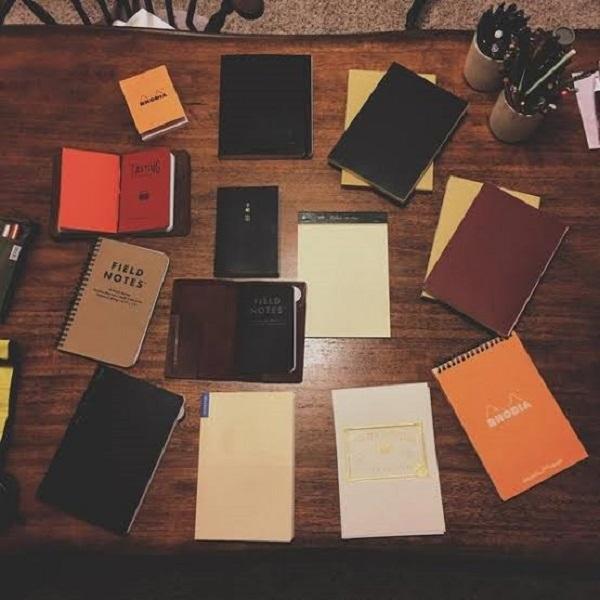Here at Wanderings we make The Wanderings Notebook and are super proud of it, but that doesn't mean weren't not, ahem, slightly addicted to every kind of notebook and journal in existence.
Roughly equivalent to 10% of my collection:

Photo @matthutcheson
There's a lot of options out there and finding the best notebook for yourself (or the person you're buying an awesome gift for) can be overwhelming, so I put together this guide to the different aspects that you'll see in notebooks and journals, as well as a few tips on what to look for. Onward!
The Basics
Here are the core characteristics of a notebook that you need to consider:
Notebook Size
One would think that there is a nice, neat, standardized system of notebook sizes, and they would be oh so terribly wrong.
Most people are passingly familiar with the classic A-Series B-Series sizing system (An A4 notebook, for example), which is a really handy as a rough guide or for more standard-sized notebooks and journals. Below, we've made this handy dandy graphic that reviews the most common sizes and some visual examples:

Here's a list of links to those notebooks:
Pocket / Passport Sized
Traveler's Notebooks
Standard A5 Sized Journals
The Rebels: Non-Standard Sizes
Notebook Material
I like to look at this in two overarching categories: Durable and Non-Durable.
Non-Durable Notebooks
You would probably want to go with a non-durable notebook for something like taking notes on the fly, schoolwork, or a planner. These will have covers made out of some kind of paper product and could be damaged more easily.
Some examples of non-durable notebooks:
Durable Notebooks
These are perfect for a cherished journal or diary, sketchbook, or keeping important notes that you would like to archive. Typically, durable notebooks are made of either leather. If you want to save what you write or draw I would also highly recommend a refillable notebook. Durability is the main reason that we made The Wanderings Notebook of top-grain leather and with refillable pages.
Here's a few examples of durable notebooks:
Paper Type
There are two variables here: What's on the paper, and how it's made.
What's On The Paper
Lined - For writing
Blank - For writing, sketching, painting, or a combination (check out this article for inspiration on different ways to combine methods in your notebook!)
Graph - Preferred by engineers, some technical designers, and nerds everywhere (looking at you Dad)
Dotted - This option has been gaining popularity lately as an unobtrusive page-type that helps to keep the layout organized while not being too visually overwhelming. It's perfect for bullet journaling. P.S. If you haven't heard of bullet journaling before please allow me to share this introductory article and say: you're welcome.

And that's not even considering custom paper types for special tasks like planner inserts.
How The Paper Is Made
The key metrics here are:
- Paper weight (measured in GSM)
- Acid free or not
Paper Weight
GSM refers to the weight of the paper, but not necessarily the density. For a full explantion check this out. GSM is most important when using fountain pens, other heavy inks, or paint in your notebook. As a frame of reference, typical high-quality office documents would be 80 - 90 GSM and company letterhead is 100 GSM. A brochure or flyer might be 150 GSM. 90+ GSM is good for fountain pen users.
Paper Acidity
Most journals (except for the really cheap ones) use acid-free paper these days. The technical details of why some paper is acid free can be found in this riveting Wikipedia article, but for most of us it's enough to know that if you want to save what you are writing or drawing then the paper should be acid free!
Refillable Journals
Obviously I am a big fan of refillable notebooks, since that's how we designed The Wanderings Notebook! There are a few advantages to this layout:
- Buy the notebook once and use it forever. Paper refills can be archived for reference once they are full of drawings, notes, or journal entries.
- Sections can be re-ordered inside the notebook to better organize ideas.
- Different refill types can be combined to keep everything in one place! Many people use The Wanderings Notebook or Midori Notebook
as a combination journal, notebook, and planner.
- Tons of accessories can be put into a refillable notebook like Zip Pocket
or Card holder

The Wanderings Notebook with refills visible
Pockets and Add-Ons
Customizing a refillable notebook is awesome, but there are some notebooks with pockets and other accessories already built in. The Moleskine Classic Notebook popularized the back-page pocket (shown below)

A great feature of refillable notebooks is that they can be customized with all kinds of pockets and folders inside. Behold!

Hopefully that got you PUMPED to customize your notebooks. Here's are list of a few accessories to get you started:
and that brings us to...
Pen Holders
Any notebook that has an elastic closure will work just fine as a pen holder. Here's how I like to keep my wooden ballpoint pen tucked into my Wanderings Notebook:
If your favorite notebook doesn't have an elastic closure or somewhere else safe to stash your pen, there are clip-on pen holders available like this one:
Midori has a similiar style as well. Check it out here.
And so finally!
Go Forth and Journal!
I hope that this article has helped you start thinking about what is important to you in a notebook, whether it be for journalling, sketching, painting, or productivity.
It would be great to hear about your main considerations when buying a new notebook. What's important to you? Where do you start?
Leave me a comment and let me know!
Happy Wanderings

